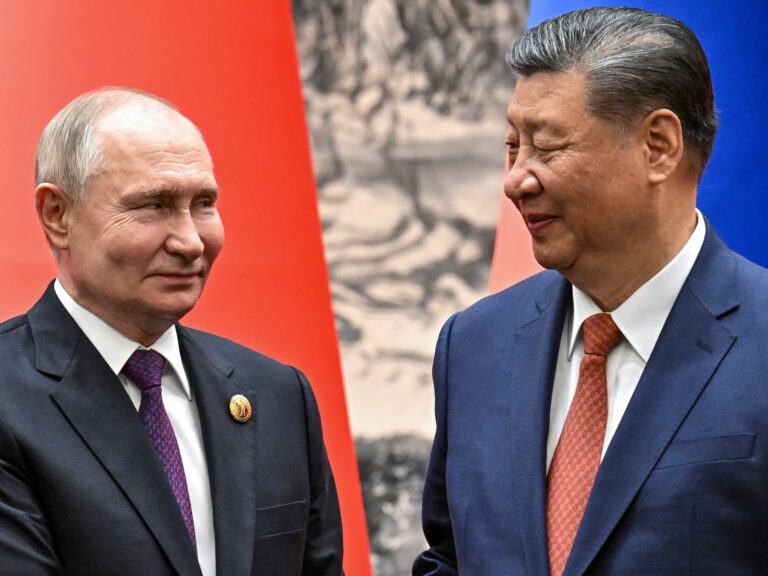As Chinese President Xi Jinping and his Russian counterpart Vladimir Putin pledged a “new era” of cooperation, experts are questioning the depth of the relationship between America’s two arch rivals and its economic impact.
The relationship between China and Russia is long and complex.
The premise is that the two major neighboring countries, with huge land masses, extreme weather areas, and sharing a long border, would be natural allies.
Historically this was not the case, but after decades of conflict, the two countries have finally come together in the face of Western sanctions against Russia.
Moscow needs strong allies to circumvent sanctions, while Beijing is also looking for allies to help create a new order that challenges the United States.
Elina Rybakova, non-resident senior fellow at the Peterson Institute for International Economics, said Putin’s visit to China was a “significant diplomatic signal of the importance of the relationship between the two countries,” especially since it came following a visit last month by US officials, including Secretary of State Antony Blinken.
The 43rd meeting between the two leaders came following an executive order by U.S. President Joe Biden threatening to impose penalties on financial institutions that help Russia evade sanctions.
The December order is worrying to Putin.
“He went to China, [Moscow] Don’t do anything that might get you in trouble
“Russia is a junior partner and this visit [from it] “We are here for China and pledge eternal friendship,” Rybakova said, adding that this sentiment has been repeated before.
Bilateral trade between the two countries reached a record high of $240 billion last year, making China now Russia’s largest trading partner, but according to a report by the Council on Foreign Relations, Russia is only China’s sixth-largest trading partner.
In a December paper she co-authored for the Center for a New American Security, Rybakova noted that Russia has also increased its international trade denominated in rubles since it began its full-scale invasion of Ukraine, with the yuan’s share of imports rising from 5 percent to between 20 and 25 percent.
The yuan’s share of the domestic market has also increased from less than 1% before February 2022 to more than 30% now, the paper said.
Sanctions have brought the two countries together, but in reality “Russia needs China more,” Rybakova said.
First, as a buyer of oil and as a supplier of military parts at a time when sanctions have shrunk markets.
“Somewhere between 70 percent and 90 percent of Russian military components are Western-made,” Rybakova said, explaining that China produces them for Western customers and the manufacturers then ship them to Russia, a process that gives “deniability to the West.”
“Russia will want to do all it can to keep China close because it faces a very real threat of global isolation, especially from more influential powers,” Michael Kugelman, director of the Wilson Center’s South Asia Institute, told Al Jazeera.
“If war [in Ukraine] “If Russian aggression continues, Moscow will need economic assistance. But Russia does not have many friends who can provide the necessary support, and China is one of the few,” he said.
At the same time, while it is good for Beijing to have a competitive source of fuel in the Middle East, it does not want Russia to become overly dependent on it and “doesn’t want to create an awkward situation where Russia is under China’s protection,” Kugelman added.
Risks to Indian interests
Analysts expect ties between the two countries to continue to expand in the foreseeable future, with China supporting Moscow wherever possible.
But there is another player in this mix that needs to be considered – India.
Rybakova noted that India has also become a major buyer of Russian crude oil, with its share increasing from less than 2% to now about 35%.
While these purchases help improve South Asian countries’ balance of payments, they certainly do not support Russia’s war in Ukraine, Kugelman said.
One reason is that there is a risk that a war could bring Russia and China closer together, which could pose a risk to Indian interests.

New Delhi fears that China, a long-time foe with which it shares a 3,440-kilometer (2,140-mile) disputed border, will use its influence over Russia to pressure Russia to scale back business with India, including the sale of S-400 missile systems.
If Russia resists Chinese pressure to cut sales to India, it will put Moscow in a tough position, jeopardizing its access to badly needed capital from China.
India is also a strong supporter of the U.S. Indo-Pacific strategy, which promises support for regional connectivity, trade and investment as the U.S. seeks to build a network to check Chinese influence.
Kugelman noted recent port calls by Russian ships in Bangladesh and Myanmar and said India was concerned that China would pressure Russia to change its naval capabilities in the Bay of Bengal.
For now, the Indian government cannot afford to do anything about this, but Moscow needs as many friends as it can get. It’s a tough balancing act.

